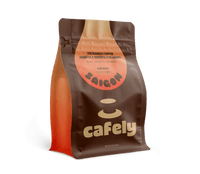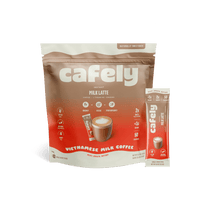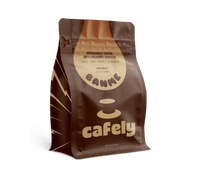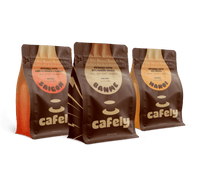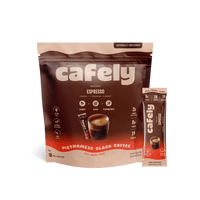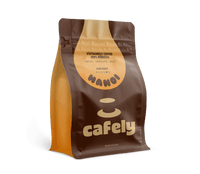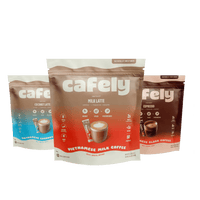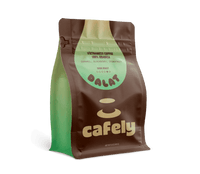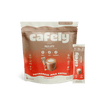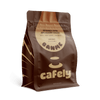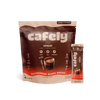Greek coffee is a unique brew that is boiled rather than brewed. Extra fine coffee is used so the grounds sink to the bottom of the cup. The process creates rich, creamy, deep-bodied coffee served in small demitasse cups.
Similar to Turkish coffee and other brews from the Middle East, Greek coffee is strong and has a light, frothy crema on top (kaimaki in Greek).
It's easy to learn how to make this coffee, but it can take years to perfect. Learn how to make Greek coffee in this step-by-step guide…
What You Need to Make Greek Coffee

Greek coffee is a simple beverage that contains only two ingredients — ground coffee beans and water. Some also add a small amount of sugar to sweeten the brew, but this is optional.
The complex flavor of Greek coffee comes from the type and quality of the coffee and its unique brewing process. To make an outstanding cup of Greek coffee, you must buy the finest coffee and master the brewing technique.
Here are the ingredients and equipment you’ll need to make Greek coffee:
Ingredients
- High-Quality Coffee Beans — Whole-bean arabica is the best option for making Greek coffee. A pre-ground arabica can also be used; just make sure it's fresh and ground extra fine.
- Water — Use fresh, filtered water to make Greek coffee.
- White Sugar (Optional) — Greek coffee is often sweetened with white, granulated sugar.
Equipment
- Coffee Grinder — You'll need a coffee grinder capable of producing an extra fine grind size. A high-quality burr grinder is the best option.
- Gas Stove — A gas stovetop or a “gazaki” (a single gas burner often used for camping and brewing) is needed to brew coffee with a briki.
- Briki — This traditional Arabic coffee pot is essential for making Greek coffee.
- Demitasse Cup — Use a small demitasse coffee cup to serve the Greek coffee.
Coffee Recommendations
Greek coffee should be made with 100% arabica coffee. Arabica beans produce a dark, bold coffee that’s smooth, sweet, and mellow. The beans should be dark roasted and ground to an extremely fine powder.
You can buy beans or pre-ground arabica coffee that’s specifically prepared for Greek coffee. This is the best route to go if you’re looking for true, untainted traditional flavors. However, any high-quality dark roast arabica coffee will produce a good cup of Greek coffee.
If you’re looking for arabica for Greek coffee try our DaLat coffee. It’s made using 100% dark roast arabica — ideal for Greek coffee. We offer whole beans (recommended) or freshly ground coffee if you prefer not to grind beans yourself.
How to Make Greek Coffee: Step-by-Step
Making Greek coffee is a relatively simple process. However, it requires love, care, and patience to craft the perfect brew.
It can take time to master this brewing method, so don’t be discouraged if your first cup tastes a little bitter or grainy. Practice really does make perfect when it comes to using a briki to make Greek coffee.
With that said, here’s how to make it:
1. Measure and Grind Your Coffee

Greek coffee requires extra-finely ground coffee. The consistency should be similar to powdered icing sugar. This grind size can only be achieved with a quality burr coffee grinder — a blade grinder is not capable of producing an extra-fine grind.
You'll need two teaspoons of ground arabica coffee per serving — this is around four to five grams of whole beans.
If you don't own a decent burr grinder, opt for a high-quality pre-ground Greek or Turkish arabica coffee.
2. Combine the Coffee and Water

To the briki, add the ground coffee and fresh, cold, filtered water. For each serving of coffee (two teaspoons), you will need 60 to 80 mL of water.
You can also add sugar at this stage if you wish to sweeten the brew. Never add sugar after brewing — this will stir up the settled grounds. Refer to the sweetness guide after this recipe if you wish to sweeten your Greek coffee.
Don't stir the coffee just yet.
3. Heat the Briki

Place the briki on your gas stove over low heat. As the mixture begins to heat, stir it gently to combine the ingredients.
Continue heating the mixture slowly, stirring occasionally. Stop stirring when you start to see the surface of the brew begin to froth and bubble.
4. Remove the Foam

When the foam rises to the surface of the brew, take the briki off the heat and remove the foam gently with a spoon. Place a small amount of foam in your serving cups.
5. Repeat the Process

Place the briki back on a low heat and wait for it to produce foam again. When the foam rises, take the briki off the heat and remove the foam with a spoon. Place the briki back on the heat and repeat this process two to three times.
6. Let the Brew Settle

After the final cycle, remove the briki from the heat and allow the fine coffee grounds to settle — this will take a few minutes.
7. Pour and Serve

Gently pour the Greek coffee into your cups. The brew should be dark, thick, and have a dense, rich foam on its surface.
Serve the brew with a small glass of cold water (optional) and enjoy. Greek coffee should be sipped gently and savored. Avoid drinking the final sip of coffee from the cup — this will contain coffee grounds.
Greek Coffee Sweetness Guide
Unlike other similar Arabic brews like Turkish coffee, Greek coffee is often served sweetened.
You cannot sweeten this brew after it's made because stirring in sugar will disturb the grounds at the bottom of the briki or cup, creating a coffee with a silty mouthfeel. Instead, the sugar must be added before brewing — this means it's essential to get the ratio right.
Here's how much sugar to add to Greek coffee for different sweetness levels:
- Sketos (Unsweetened) — No sugar.
- Metrios (Semi-Sweet) — One teaspoon of sugar per serving.
- Glykos (Sweet) — Two teaspoons of sugar per serving.
- Poli Glykos (Very Sweet) — Three teaspoons of sugar per serving.
Add the desired amount of sugar to your briki when you add the ground coffee and water. Brew as normal.
Best Food Pairings for Greek Coffee
Greek coffee is traditionally served in small demitasse cups with saucers. The strong, concentrated brew is (almost) always served alongside a cold glass of water, but certain foods are also regularly paired with the brew.
Here are some popular food pairings for Greek coffee:
1. Loukoumi (Greek Delight)
Loukoumi is “Greek delight” — a sweet, gummy, sugar-coated candy. These chewy delights come in several different natural flavors, including rose, mastiha, citrus, and almond.
Loukoumi provides a sweet, fragrant contrast to the bitter, rich, dark flavors of Greek coffee. The soft, jelly-like texture melts in the mouth and coats the palate — providing a sweet note with each sip of coffee.
2. Loukoumades (Greek Doughnuts)

Loukoumades are small, crispy, fried doughnut balls that are drizzled with honey or syrup. They're often garnished with cinnamon or crushed nuts to provide contrasting textures and flavors.
The light, airy texture and sweet, nutty flavor of loukoumades balance out the rich, bitter notes of Greek coffee — making these delightful treats the perfect pairing.
3. Baklava (Greek Pastries)
Baklava is a popular Arabic dessert that can be found all over Greece and several other Balkan and Middle Eastern countries. It's a sweet dessert made from flaky phyllo pastry, honey, and finely chopped nuts.
Baklava is a common pairing across countries that consume Arabic coffee, like the Greeks. The combination of its crisp texture and syrupy sweetness enhance the depth of the coffee and balance out its bitter edge. The nuttiness of baklava also compliments the natural earthy and nutty undertones of arabica coffee.
4. Melomakarona (Greek Cookies)
Melomakarona are essentially “Greek Cookies.” These soft, spiced biscuits are soaked in honey or syrup and are topped with crushed walnuts. They offer a similar taste to baklava but a softer, chewier texture.
The warm flavors of cinnamon, nutmeg, and orange zest in these cookies pair harmoniously with the dark, bold flavors of Greek coffee. The sweetness and nuttiness of melomakarona also complement the earthy, nutty undertones of the coffee.
5. Koulouri (Sesame Bread)
Koulouri is a savory bread that's similar to a pretzel. It's a crunchy, sesame-crusted bread ring with a soft and chewy center. This simple snack doesn't explode the senses with flavor, but it's a versatile snack that pairs well with several drinks, including Greek coffee.
The sesame flavor and light, airy bread enhance the roasted, nutty notes of Greek coffee. The mild saltiness of koulouri balances out the bitter notes and brings out the arabica coffee's sweetness.
6. Tyropita (Feta-Filled Pastry)
Tyropita is a popular feta-filled pastry. The creamy, salty feta cheese is wrapped in flaky phyllo pastry to create a delightful, savory snack that can be enjoyed as part of lunch or dinner.
The salty, tangy taste of feta and the light, flaky texture of the phyllo pastry make this savory snack perfect for pairing with Greek coffee. It contrasts perfectly with the bold bitter flavors of the coffee and compliments its natural nutty, earthy undertones. The saltiness of tyropita also enhances the natural sweetness of arabica, making the cup of Greek coffee taste "sweeter" than it actually is.
7. Olives
Olives are a common snack in Greece. They're served alongside coffee, alcohol, and as a side dish with meals. Olives are a staple of Greek cuisine, and it's no surprise they're often served alongside Greek coffee.
Olives provide a salty, umami-rich experience that offsets the more intense flavors of Greek coffee. They can also enhance the natural sweetness of the beans and compliment certain undertones in the brew — floral and fruity notes especially.
FAQs: Greek Coffee
Have further questions about Greek coffee and other caffeinated beverages?
Check out the frequently asked questions below:
1. What Type Of Coffee Beans Are Best For Greek Coffee?
Greek coffee is traditionally made using arabica coffee beans. The beans are typically roasted dark and ground extra fine to a texture similar to talcum powder.
2. What Is The Foam On Top Of Greek Coffee?
The foam on top of Greek coffee is known as kaimaki. It's a rich crema that's made during the brewing process. It's collected as the coffee heats and releases gasses, saved and served on top once the coffee is brewed.
3. What Is The Coffee-To-Water Ratio For Greek Coffee?
The standard coffee to water ratio is 1:3 or 1:4 depending on the personal preference of the brewer. Around one tablespoon of extra finely ground coffee is used for every two ounces (60 mL) of water.
4. Can You Make Greek Coffee Without A Briki?
Yes. You can make Greek coffee without a briki by using a small saucepan or pot. However, it's difficult to achieve the same depth of flavor and signature kaimaki (crema) without using a briki.
5. Can You Add Spices To Greek Coffee?

Yes. You can add spices to Greek coffee. Although not traditional, cardamom, cinnamon, cloves, nutmeg, or vanilla can be added to spice up a briki of Greek coffee.
6. Can You Make Greek Coffee With Milk?
Milk isn’t traditionally served with Greek coffee. The unfiltered brewing process makes it difficult to add milk. The milk cannot be added after brewing because it will stir up the fine grounds in the bottom of the cup.
7. How Strong Is Greek Coffee Compared To Other Coffees?
A typical 60 to 90 mL cup of Greek coffee contains 40 to 50 mg of caffeine. Compared to espresso (around 63 mg per 60 mL serving), it's weaker. However, compared to drip coffee (around 95 mg per 240 mL serving), it's stronger.
8. Can You Use A French Press To Make Greek Coffee?
No. You cannot make traditional Greek coffee using a French press. The French press uses coarsely ground coffee and immersion to extract the coffee, which creates a weaker brew with a thinner body.
9. What Is The Best Coffee Grinder For Greek Coffee?
Arabica coffee beans must be ground extremely fine to make Greek coffee. Burr grinders are typically preferred over blade grinders because they’re capable of producing an extra fine grind size.
10. Is Greek Coffee the Same as Turkish Coffee?
Greek coffee is similar to Turkish coffee. They're both strong, concentrated coffees that are served in small cups. However, Turkish coffee is brewed slightly differently than Greek coffee.
